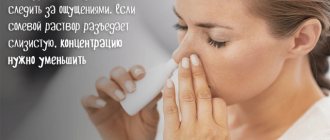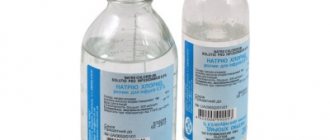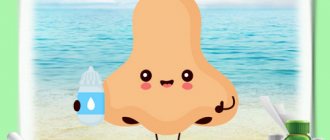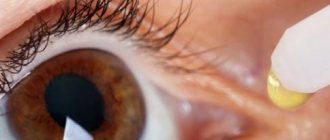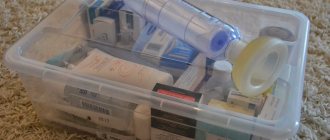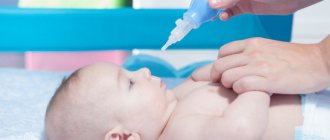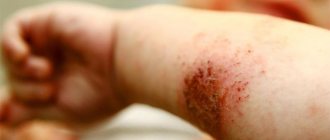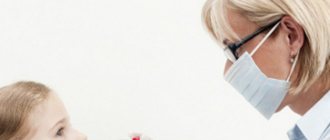The method of rinsing the nose with the well-known physiological solution of sodium chloride (saline) is probably the safest and most common among many practices for the treatment of snot. It is used in hospitals and at home, and sometimes patients prepare the solution themselves, using homemade remedies.
Therefore, when patients ask the doctor whether it is possible to rinse their nose with saline solution, the answer will always be only a positive answer: “of course you can.”
To dispel all doubts, first let's figure out what saline solution is, what it consists of, whether there is a replacement for it among pharmaceutical drugs, and how to prepare an analogue without leaving home.
Isotonic sodium chloride solution - main components, properties and indications
Compound
Despite such a long name, saline solution has a very simple composition. Simply put, this is a regular saline solution (table salt and water), but prepared not in the kitchen at home, but under special sterile conditions.
To prepare saline solution, pharmacists use only distilled water. It turns out that this product contains only two components - 9 grams of sodium chloride and distilled water (up to a liter).
Sometimes patients, having bought an isotonic sodium chloride solution in a pharmacy, begin to doubt how to rinse their nose with saline solution, if the label clearly states that the product is intended for injection. That's right, it is this saline solution that is needed to rinse the nasal passages. Even on Dr. Komarovsky’s website there are explanations about this.
Important! Sodium chloride solution can be isotonic or hypertonic. Nasal rinsing is usually carried out with isotonic sodium chloride solution (NaCl 0/9%). You can perform this procedure yourself. Hypertonic solution, especially in pediatric practice, is prescribed only by a doctor. Indications for its use are severe swelling and excessive amounts of purulent discharge in the nose.
How does saline solution work?
After several procedures, patients notice that it has become easier to breathe, the mucus has changed its viscosity, it comes out easily, and the dryness in the nose has gone away. Liquid snot, on the contrary, becomes thicker and does not “run” like a stream over the lips.
This effect is achieved due to the antimicrobial effect of sodium chloride. Bacteria begin to die, swelling and inflammation subside, and the mucous membrane is restored.
In order to rinse your nose with saline solution when you have a runny nose, you need to purchase the product at the pharmacy, and also have a pipette or disposable sterile syringe on hand.
Indications for nasal rinsing
Saline solution is used for common colds, vasomotor and allergic rhinitis, adenoids, and bacterial rhinitis. In babies, saline solution is widely used to cleanse the nose of mucus and bugs.
There are no restrictions on the use of saline solution. It cannot be overdosed, so there are no strict dosages in terms of the number and time of procedures. Of course, you don’t need to pour liters of the solution; it’s always better to consult a doctor and find out how to properly, following all the rules, rinse your nose with saline solution specifically in your case.
How to make homemade saline solution for nasal rinsing
Sodium chloride (NaCl) is the most important component for maintaining the osmotic pressure of blood plasma and extracellular fluid. The concentration in tears, blood plasma, and tissue fluids is approximately 0.9%, the same as that of a pharmaceutical saline solution of sodium chloride in water. The concentration of the hypertonic solution is higher – 3-5-10%.
Pharmaceutical saline solution is used for detoxification, for dehydration of the body and thickening of the blood, and as a solvent for medications. The distilled water used for preparation is distilled in glass equipment.
External use helps remove pus and has an antimicrobial effect.
It is better to prepare a saline solution for rinsing the nose from table (edible) non-iodized salt - sea salt contains other microelements.
To completely destroy all bacteria and microorganisms, boil water for 3-5 minutes and let cool.
Thoroughly wash, disinfect, scald the inside of a glass bottle with a sealed lid for the finished solution with boiling water.
Proportion of table salt in prepared boiled water:
- 1/2 tsp. for 250 ml (glass).
Low temperature storage in the refrigerator reduces the risk of microorganism growth.
Rinse your nose with warm saline. Hot causes burns. Too fresh or too salty - itching, burning.
How to properly and safely rinse your nose with saline at home?
It is much more convenient to use a pharmaceutical solution, because...
it is produced not only in ampoules, but also in containers and bottles, and the dosages are very diverse. As for the price, it is simply symbolic. For example, ampoules of 5 ml No. 10 cost only 20 rubles, and a bottle of solution (400 ml) costs about 28 rubles. Most doctors still advise purchasing saline solution and its analogues at the pharmacy , because... At home, it is impossible to replicate the clear proportions and sterility of the product.
Despite the cheapness of saline solution, many people prepare the solution on their own, the main thing is to try to more accurately approach the pharmaceutical proportions of water and salt.
How to Make Saline Nasal Solution
The recipe for preparing a saline solution to clear mucus from the nose is simple; it requires adherence to clearly established proportions. If these proportions are not observed, the desired effectiveness of the procedure will not be achieved. So, how to prepare saline solution correctly? You will need one liter of warm boiled water and 1 teaspoon of table salt, which must be diluted until completely dissolved. The resulting liquid is recommended for use by both adults and children.
- Reinstalling windows 7 on a laptop
- How to spend MTS bonuses
- Painkillers - list
A ready-made sterile solution is sold at the pharmacy for those who cannot, for one reason or another, prepare it at home. The price of the drug is quite affordable, so it will not cause large financial expenses. The sterile solution is best used in combination with other drugs, directly for inhalation. The quality of the liquid in this case should be high.
Homemade saline solution - recipe
To make homemade saline solution, prepare boiled water in advance. It should not be hot, the ideal temperature is 36 degrees. You will need exactly 9 grams of salt (it is advisable to have special scales for milligrams). Water and salt are thoroughly mixed and then filtered through one layer of gauze. The homemade solution is ready.
You can rinse the nose with homemade saline solution for adults, as well as for children over 3 years old. For young children, as an alternative, only saline solutions purchased at a pharmacy are suitable, for example, the same isotonic sodium chloride solution, aquamaris, or another remedy.
The procedure for rinsing the nose in children (from three years old) and in adults
The procedure itself is not complicated.
- The solution is drawn into a regular pipette, filling its volume completely, and poured into each nostril one by one.
- Instead of a pipette, you can use a disposable syringe; 1–2 ml of solution is drawn into it.
- The procedure is performed standing over a sink, or you can place a tray under your chin where the solution will flow out and not stain your clothes.
Sometimes the nose is so “clogged” that the saline solution cannot penetrate deep enough, then it is recommended to pre-drip vasoconstrictor drops into the nasal passages: tizin, galazolin, adrianol, xymelin, nazol or others.
Children don’t always let nose drops be put in their nose easily, so you can’t do this without cunning and ingenuity. You can offer a playful form of treatment , for example, a child instills drops into a teddy bear, and the mother instills drops into him . Various distractions are also suitable - bright books, TV, or other ingenuity, whatever the distracting assistants have enough imagination for.
Adults very often use the old grandfather’s method: they pour homemade saline solution into the palm of their hand, cover one nostril with their finger, and use the free nasal passage to inhale the solution. This procedure is continued until the nostrils are completely cleansed. Then the same is done with the second nostril. This form of treatment is suitable for lazy patients who do not like to devote a lot of time to therapeutic “lotions”.
Sometimes a neti pot is used to rinse and cleanse the nose. A solution is placed in it and poured into each nostril one by one. This device is used by patients who take treatment seriously, and sometimes even with great passion for each treatment method.
How to safely rinse a small child's nose with saline?
There are no special precautions for this procedure. Saline solution is a safe product and cannot harm. You just need to be careful when performing the procedures themselves.
- Carefully bury the nose with a pipette, bulb or syringe so as not to injure the baby.
- It is imperative to hold the child's head so that he does not throw it back, because... this leads to choking and choking.
If the procedure is performed according to all the rules, then there can be no negative consequences.
How to rinse a baby's nose with saline?
It is clear that palms and teapots are not suitable for small noses.
And in general, it is better for the youngest patients to rinse their nose with a pharmaceutical saline solution or its analogues: Humer, Salin, Aqualor, Aquamaris, Quix and others. If you don’t have such solutions at hand, and you need to rinse your nose with saline, you will have to use a pipette or a mini syringe (baby bulb). They must be boiled and cooled. A child under one year old needs to rinse his nose with saline carefully, and as a rule, no more than 3 drops of the product are placed in a pipette for each nostril.
The child should be placed on his back, his head should be fixed, and the solution should be carefully introduced into each nasal passage. After a few minutes, small flagella made from sponges are used to carefully remove the crusts and soots from the baby. It is impossible to screw the flagella deeply into the nose, because... such manipulations can damage the delicate mucous membrane of the baby.
The pharmacy chain sells special aspirators for cleaning children's noses. They are also widely used and recommended by pediatricians.
Precautionary measures
Despite the safety of the medicine, in practice there are a number of situations in which saline solution is used with caution:
- at risk of nosebleeds;
- the presence of polyps and tumors in the nasal passages;
- with a deviated nasal septum;
- swelling of the mucous membrane.
It is also necessary to be careful when rinsing small children with the product. It is recommended to carry out the procedure no later than two hours before going to bed at night or before leaving the house. It is recommended to use nasal drops 20 minutes after irrigation. Therefore, it is necessary to think through the treatment regimen in advance in order to prevent possible complications from occurring.
In addition, we recommend that you read the material on washing with hydrogen peroxide in this article.
Features of rinsing the nose with saline solution for inflammation of the maxillary sinuses
In this situation, saline solution acts only as an auxiliary agent, and it is not able to solve the problem of sinusitis on its own . In a hospital setting, the sinus cavity is washed with saline solution, clearing the inflamed area of purulent contents. Thanks to constant rinsing, congestion in the sinuses is prevented. The procedure is performed only by an otolaryngologist.
In addition to saline solution, local and systemic antibiotics, antihistamines, and antiseptic solutions are used: furatsilin, miramistin, chlorhexidine, dekasan. After the cessation of the acute period of the disease, physiotherapeutic procedures are prescribed.
Article on the topic - How to quickly cure sinusitis at home.
How to rinse your nose with sinusitis.
Healing procedures
Water with salt for a runny nose is effectively used to rinse the nose. Contraindication is children under 4 years of age, as there is a high risk of liquid with pathogenic microorganisms entering the hearing organs, bronchi and lungs.
If the inflammation has affected the entire nasopharynx, not only rinsing the nasal passages, but also gargling with saline solution. The procedure allows you to disinfect the surface and prevent bacteria and viruses from entering the lower parts of the respiratory system.
Even a small child can drip saline solution into the nose at home. The age of the patient will determine how many drops to instill. In the baby's nose, it is enough to administer two drops into each nostril up to 5 times a day. If a child over two years old has a runny nose, the dosage is increased to 4 drops. For adults, the dosage can be equal to half a pipette.
Inhalations with saline solution are effective in children. Inhalations dilute sputum, clear the respiratory tract of accumulated mucus, soften and moisturize the mucous surface. You can add essential oils to the saline solution. But when adding essential oils to newborns, you need to be careful, as the components can cause an allergic reaction.
Before pouring the product into the nebulizer cup, you need to warm it up in your hand. The optimal temperature of the solution for inhalation for a child with a runny nose is 35 degrees. Inhalation with saline solution for a runny nose in children is carried out twice a day for no longer than three minutes. Inhalations should be done two hours before meals or an hour after.
In newborns up to 3–4 months, the body adapts to new conditions. The nasal mucosa reacts to any changes and increased formation of snot occurs. If you have a physiological runny nose, it is better not to use saline solution in your nose.
How to rinse your nose with saline according to Komarovsky?
The famous doctor Komarovsky does not see any problems with using saline solution prepared at home. Addressing parents, the doctor gives the following advice: “dissolve one teaspoon of salt in 1 liter of boiled water, shake, and get the most correct solution for rinsing the nose.”
There are no age proportions for children, except for newborn babies. In the first weeks of life, saline solution is administered in drops, starting from one and increasing to a quarter of a teaspoon for each nasal passage.
Older children (from one to three years) are prescribed larger amounts of rinsing , and 0.5 volumes of a standard pharmacy pipette of solution are taken for each nostril. The intensity of the procedures varies. Sometimes the nose is washed every hour, or three procedures are enough for the whole day.
The doctor advises the youngest patients to use a syringe (mini), and for older children a disposable syringe.
Older children are seated on a chair, given a small bowl in their hands, and asked to lean closer to it, while lowering their heads. You also need to make sure that the child's mouth is slightly open. The solution is poured into the child’s nostril with a syringe, and it gradually begins to flow out of it, removing “bad” mucus along the way.
During the procedure, mucus may flow out of the other nostril, it’s okay, that’s how it should be. Washing is carried out until “clean waters”. At the end of the procedure, the child blows his nose. If necessary, a few minutes after cleansing the nose, medicinal drops prescribed by the doctor are administered.
An article on the topic - how to treat a child’s runny nose using Komarovsky’s methods.
How to clean a child's nose
conclusions
- Saline solution is a unique and effective means of combating viruses and microbes.
- Wide spectrum of action of the drug.
- It is characterized by low cost.
- Used in the treatment of children, pregnant and lactating women.
- The shelf life depends on the method of “extracting” the liquid from the container or the method of its preparation.
- Do not use if there is a risk of bleeding or swelling of the mucous membrane.
- The number of procedures using the drug depends on the severity of the disease.
What else is used to rinse the nose besides saline?
Pharmacy saline solutions
Saline solution has analogues, although they are all significantly more expensive.
Its main substitutes are pharmaceutical solutions containing purified sea water. They are produced in small bottles and sprays, and for ordinary sea water in minimal volumes you have to pay an expensive amount. Such means include:
- quickx, aquamaris,
- physiomer, salin,
- aqualor, humer,
- morenasal.
For example, Quix nasal spray (30 ml) costs about 340 rubles, and for a children's Humera with a volume of 150 ml, you will have to fork out and pay 620 rubles. Isn’t it a little expensive for the expanses of water that give away their healing waters for free? Does cleaning and packaging really increase the price of regular seawater that much?
That is why not only patients, but also some doctors are still hesitant about what, for example, is better - saline solution or Aqualor, saline solution or Aquamaris, saline solution or Quix?
Some people welcome only sterile preparations, and for them the price is not a problem. Others, on the contrary, think there is no need to overpay, because ordinary salt with water has a bactericidal effect and does not require special sterility. The nasal passages do not belong to the sterility zone; they are always in contact with the external environment, so homemade saline solution is quite suitable for rinsing.
An undoubted advantage in the direction of pharmaceutical saline solutions is considered to be infancy, when the slightest excess of salt in the solution can cause irritation in the tiny nasal passages. From birth, even in maternity hospitals, mothers are advised to clean their newborn’s noses with Aqualor or Aquamaris - these are some of the popular drugs among neonatologists.
An article on the topic - how to properly rinse your nose with Dolphin.
Herbal infusions and decoctions
If the patient does not have serious complications of rhinitis, then instead of saline solution the following infusions or decoctions of the following herbs can be used:
- yarrow;
- chamomile;
- calendula;
- eucalyptus;
- sequences;
- oak bark;
- sage
The most popular and safest of all herbs is chamomile. It is used from the very first days of newborn life.
For rinsing, it is most convenient to use infusions: a tablespoon of herbs per 200 ml of boiling water. Leave the mixture for 40 minutes, strain, and start rinsing your nose. The amount of infusion for one nostril should be at least 1 ml.
For what diseases
Saline solution is considered a set of beneficial salt minerals included in its composition. Therefore, it is used for all kinds of pathologies in the nose and throat.
Treatment of a runny nose
The solution allows you to quickly cure acute rhinitis (runny nose), reduce the need for the use of other medications (for example, antibiotics). With timely treatment of the nasal cavity, the disease can be reduced to two to three days.
Efficacy for sinusitis
For a disease such as purulent sinusitis, saline solution is recommended as a medicine for washing pus from the sinuses and nasal appendages. Thanks to the procedure, you can prevent and stop the spread of germs. Irrigation should be carried out every hour. It is also recommended to alternate means when washing (for the first time - saline solution, then - with a liquid that contains herbal preparations).
For sinusitis, rinsing the nose with saline is an additional measure. It is not an independent operation; it is used in combination.
Use for nasal congestion
The use of saline solution with other anti-congestion medications is effective in clearing the nasal cavity of secretions and crusts that have formed. It is worth considering that the use of vasoconstrictor drops after rinsing the nose with sodium chloride is recommended after 15-20 minutes.
How often can the solution be used for ear diseases?
Sodium chloride is also recommended to be used as a liquid for ear diseases (for example, if there are plugs in the ears). To do this, you should pay attention to the temperature of the solution. It should be warm so as not to provoke the risk of complications.
Rinse throat
For throat diseases, the solution is also used. Moreover, it is used in pharmaceutical concentration. There is no need to dilute it with water. You need to gargle at least twice a day. In a situation where the disease occurs with complications, it is necessary to treat the throat at least five times a day. In this case, you need to combine it with the use of other antiseptic solutions. It is recommended to irrigate not only the throat, but also the nose. For inflamed tonsils, it is recommended not to rinse, but to organize absolute rinsing (the liquid passes through the nose into the mouth).
